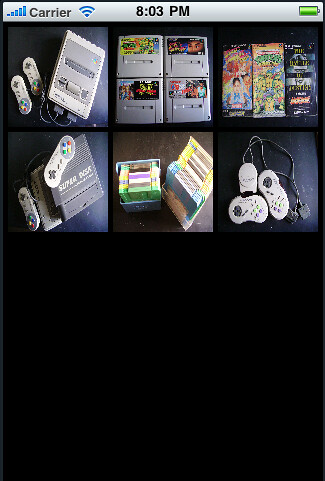參考資料:
- Navigation Controller + UIToolbar
- Color image on a UIBarButtonItem on a UIToolBar?
- UIImage: Resize, then Crop
程式碼:
- (UIImage*)imageByScalingAndCroppingForSize:(CGSize)targetSize;
@end
@implementation UIImage (Extras)
- (UIImage*)imageByScalingAndCroppingForSize:(CGSize)targetSize
{
UIImage *sourceImage = self;
UIImage *newImage = nil;
CGSize imageSize = sourceImage.size;
CGFloat width = imageSize.width;
CGFloat height = imageSize.height;
CGFloat targetWidth = targetSize.width;
CGFloat targetHeight = targetSize.height;
CGFloat scaleFactor = 0.0;
CGFloat scaledWidth = targetWidth;
CGFloat scaledHeight = targetHeight;
CGPoint thumbnailPoint = CGPointMake(0.0,0.0);
if (CGSizeEqualToSize(imageSize, targetSize) == NO)
{
CGFloat widthFactor = targetWidth / width;
CGFloat heightFactor = targetHeight / height;
if (widthFactor > heightFactor)
scaleFactor = widthFactor; // scale to fit height
else
scaleFactor = heightFactor; // scale to fit width
scaledWidth = width * scaleFactor;
scaledHeight = height * scaleFactor;
// center the image
if (widthFactor > heightFactor)
{
thumbnailPoint.y = (targetHeight - scaledHeight) * 0.5;
}
else
if (widthFactor < heightFactor)
{
thumbnailPoint.x = (targetWidth - scaledWidth) * 0.5;
}
}
UIGraphicsBeginImageContext(targetSize); // this will crop
CGRect thumbnailRect = CGRectZero;
thumbnailRect.origin = thumbnailPoint;
thumbnailRect.size.width = scaledWidth;
thumbnailRect.size.height = scaledHeight;
[sourceImage drawInRect:thumbnailRect];
newImage = UIGraphicsGetImageFromCurrentImageContext();
if(newImage == nil)
NSLog(@"could not scale image");
//pop the context to get back to the default
UIGraphicsEndImageContext();
return newImage;
}
@end
- (void)aButton:(UIButton *)sender
{
switch (sender.tag) {
case 1:
NSLog(@"Facebook");
break;
case 2:
NSLog(@"Twitter");
break;
case 3:
NSLog(@"Tumblr");
break;
case 4:
NSLog(@"Plurk");
break;
default:
break;
}
}
- (BOOL)application:(UIApplication *)application didFinishLaunchingWithOptions:(NSDictionary *)launchOptions {
// Override point for customization after application launch.
//Initialize the toolbar
UIToolbar *toolbar = [[UIToolbar alloc] init];
toolbar.barStyle = UIBarStyleDefault;
toolbar.alpha = 0.8;
//Set the toolbar to fit the width of the app.
[toolbar sizeToFit];
//Caclulate the height of the toolbar
CGFloat toolbarHeight = [toolbar frame].size.height;
//Get the bounds of the parent view
CGRect rootViewBounds = [[UIScreen mainScreen] bounds];
//Get the height of the parent view.
CGFloat rootViewHeight = CGRectGetHeight(rootViewBounds);
//Get the width of the parent view,
CGFloat rootViewWidth = CGRectGetWidth(rootViewBounds);
//Create a rectangle for the toolbar
CGRect rectArea = CGRectMake(0, rootViewHeight - toolbarHeight, rootViewWidth, toolbarHeight);
//Reposition and resize the receiver
[toolbar setFrame:rectArea];
NSMutableArray *barButtonItemList = [[NSMutableArray alloc] init];
CGFloat thumbWidth = 42 , thumbHeight = 42;
{
UIImage *image = [[UIImage imageNamed:@"facebook_icon.png"] imageByScalingAndCroppingForSize:CGSizeMake(thumbWidth, thumbHeight)];
UIButton *button = [[UIButton alloc] init];
[button setTag:1];
[button setImage:image forState:UIControlStateNormal];
[button setFrame:CGRectMake(0, 0, image.size.width, image.size.height)];
[button addTarget:self action:@selector(aButton:) forControlEvents:UIControlEventTouchDown];
UIBarButtonItem *barButton = [[UIBarButtonItem alloc] initWithCustomView:button];
[button release];
[barButtonItemList addObject:barButton];
[barButton release];
}
{
UIImage *image = [[UIImage imageNamed:@"twitter_icon.png"] imageByScalingAndCroppingForSize:CGSizeMake(thumbWidth, thumbHeight)];
UIButton *button = [[UIButton alloc] init];
[button setTag:2];
[button setImage:image forState:UIControlStateNormal];
[button setFrame:CGRectMake(0, 0, image.size.width, image.size.height)];
[button addTarget:self action:@selector(aButton:) forControlEvents:UIControlEventTouchDown];
UIBarButtonItem *barButton = [[UIBarButtonItem alloc] initWithCustomView:button];
[button release];
[barButtonItemList addObject:barButton];
[barButton release];
}
{
UIImage *image = [[UIImage imageNamed:@"tumblr_icon.png"] imageByScalingAndCroppingForSize:CGSizeMake(thumbWidth, thumbHeight)];
UIButton *button = [[UIButton alloc] init];
[button setTag:3];
[button setImage:image forState:UIControlStateNormal];
[button setFrame:CGRectMake(0, 0, image.size.width, image.size.height)];
[button addTarget:self action:@selector(aButton:) forControlEvents:UIControlEventTouchDown];
UIBarButtonItem *barButton = [[UIBarButtonItem alloc] initWithCustomView:button];
[button release];
[barButtonItemList addObject:barButton];
[barButton release];
}
{
UIImage *image = [[UIImage imageNamed:@"plurk_icon.png"] imageByScalingAndCroppingForSize:CGSizeMake(thumbWidth, thumbHeight)];
UIButton *button = [[UIButton alloc] init];
[button setTag:4];
[button setImage:image forState:UIControlStateNormal];
[button setFrame:CGRectMake(0, 0, image.size.width, image.size.height)];
[button addTarget:self action:@selector(aButton:) forControlEvents:UIControlEventTouchDown];
UIBarButtonItem *barButton = [[UIBarButtonItem alloc] initWithCustomView:button];
[button release];
[barButtonItemList addObject:barButton];
[barButton release];
}
[toolbar setItems:barButtonItemList];
[window addSubview:toolbar];
[window makeKeyAndVisible];
return YES;
}
